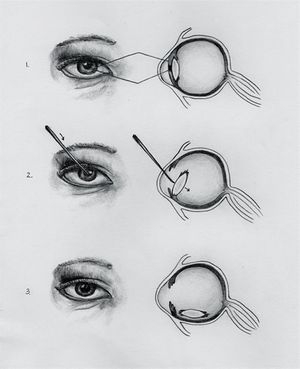Cataract couching
Couching
In sub-Saharan Africa, Sudan, Morocco, India, Nepal, China, and Yemen, couching, a method of traditional cataract treatment, is employed. As shown in the figure below, it typically involves the use of a sharp or blunt instrument to dislocate the cataract lens and push it back into the posterior chamber of the eye. Couching differs from cataract surgery (which removes the lens instead of moving it back into the eyeball) or lens replacement (where the old lens is removed and a new lens, usually glass or plastic, is sutured into place).
Couching is the oldest traditional technique documented to treat cataracts. It was first documented and practiced in the 6th century B.C. by the Hindu surgeon Sushruta and was later adopted from India by the Greeks and Romans as well as the Egyptians, Arabs and Europeans. It was the only method of cataract treatment until the 19th century. Couching is normally performed by traditional healers, although not by most community-based healers. Couchers are observed as dominantly male and itinerant, providing minimal follow-up care.
Most literature on couching has examined the visual acuity of couched eyes and the risk factors associated with the procedure. Studies show that couched eyes have significantly poorer vision post-operatively and are associated with a much higher incidence of complications and subsequent blindness when compared with eyes that undergo biomedical cataract surgery. Most ophthalmologists report a complete loss of sight for at least 50% of couched patients – defined as visual acuity less than 3/60 according to WHO Categories of Visual Impairment – and complications such as corneal scarring, retinal detachment, secondary glaucoma, uveitis, optic nerve atrophy, and endophthalmitis. As a result, couching has been dismissed by most ophthalmologists, who have concluded that it is highly unsafe and ineffective.
However, studies suggest that in some cases, if couching is performed carefully, it can present a somewhat viable alternative to cataract surgery. Schrader examined 65 eyes from 48 patients from northeast Nigeria who had been treated for cataracts by couching. Refractive correction for optimal vision of between -2.00 to +10.00 D was provided. Forty-two of the 65 eyes examined had a corrected visual acuity of between 20/20 and 20/40, and sixteen eyes were corrected to between 20/40 and 20/200. The remaining seven eyes had a visual acuity of less than 20/200 and were associated with previous or concomitant pathology. In addition, in a prospective study that lasted 5 years, Belyaev and Barachkov reported on 68 eyes couched in a clinical setting. In 26 eyes with no previously existing pathology, vision was 20/20, whereas eyes with the previous pathology had a mean visual acuity of 20/50. Complications, including capsule rupture, and secondary glaucoma, occurred in only three cases.
Cases when couching is associated with good vision and few complications can be explained by Girard’s findings. He completed an experiment that investigated a modified method of couching that relocated the lens using a frozen probe and zonulolytic agents like alpha-chymotrypsin. In this technique, the lens capsule and the anterior vitreous hyaloid remain intact. He showed that when the entire lens, including the capsule, is dislocated downwards and the anterior vitreous hyaloid membrane is not damaged, complications are unlikely to occur and good vision is possible. Thus, one can infer from Girard’s experiment that eyes with no previous pathologic conditions that are couched carefully without damaging the anterior vitreous hyaloid can be restored to good vision after receiving refractive correction with spectacles. Despite these observations, the number of successful coaching procedures compared with successful cataract surgeries is remarkably low. The complications outweigh the possible benefits and couching is not advised as a method of treatment for cataracts.
External links
Chat rooms • What links here • Copyright info • Contact information • Category:Root
